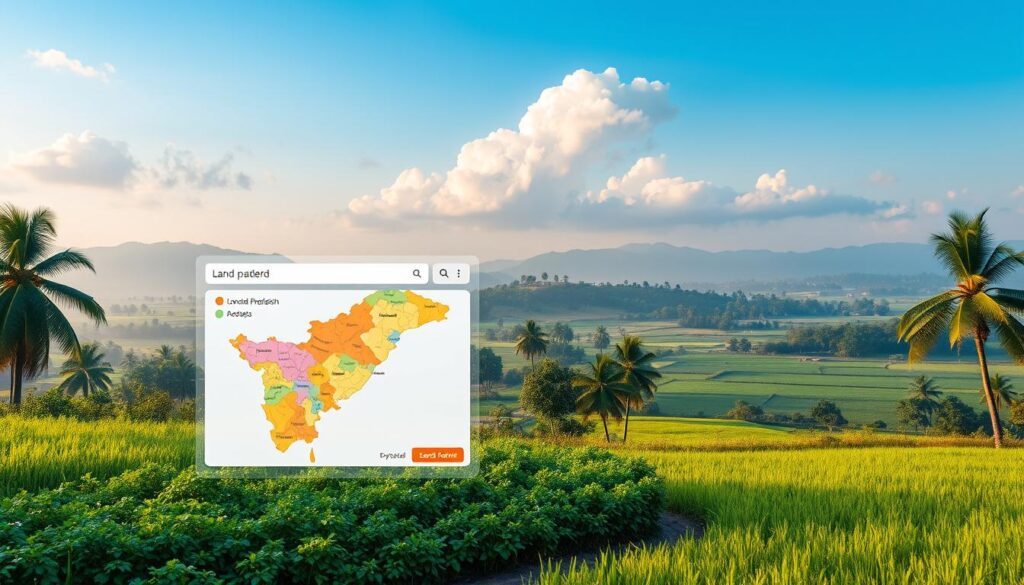Meebhoomi: Land Records Portal for Andhra Pradesh
Did you know the 18th PM Kisan Status is now on Meebhoomi? This shows how important digital land management is in Andhra Pradesh. Meebhoomi has changed how we get land records and property info.
Meebhoomi is your go-to for land documents in Andhra Pradesh. It has everything from 1-బి అడంగల్ (Adangal) to Village Maps. It also has E-Passbook Status, FMB, and Land Conversion details. This digital change makes managing property easier for everyone.
The portal makes things clear with its wide range of services. You can see ROFR Adangal/Village 1-B records and check mutation and LP record corrections. You can also view land use transformation data. Services like ROR-1B and Adangal certified copies cost just Rs. 25 each.
Even though it has a 2.9 out of 5 rating from 1,320 reviews, Meebhoomi keeps getting better. People like how it helps them find land records, but some say it’s slow. As Meebhoomi improves, it shows Andhra Pradesh’s dedication to digital land management and better e-governance.
Introduction to Meebhoomi
Meebhoomi AP is a new online place for property registration. It started in 2015 by the Andhra Pradesh Revenue Department. It’s called “Meebhoomi,” which means “Our Land,” to show it’s for everyone.
Purpose and Significance
Meebhoomi aims to make Andhra Pradesh’s land records digital. It makes getting important documents easy. You can find things like Adangal, ROR-1B records, and e-passbooks here.
Management by Revenue Department
The Andhra Pradesh Revenue Department runs Meebhoomi. They keep the records right and handle tasks like mutations and land changes. It’s a key place for all land questions and actions.
| Service | Cost | Availability |
|---|---|---|
| ROR-1B Certified Copy | Rs. 25 | Online |
| Adangal Certified Copy | Rs. 25 | Online |
| Village Maps Copy | Rs. 35 | Online |
| E-Passbook Download | Free | Online |
| Aadhaar Linking | Free | Online |
Key Features of the Meebhoomi Portal
The Meebhoomi portal was launched in June 2015 by the Andhra Pradesh government. It offers a wide range of land record services. Users can find important documents like the ROR (record of rights), 1-b register, and adangal online.
One of the main features is searching and viewing land records. Landowners can easily find their ROR-1B, which shows who owns the land. They can also see details about the land and what crops are grown there. The system lets users check their survey numbers and pahani records too.
Meebhoomi has digital maps of villages and land parcels. This lets users see where their property is. The electronic passbook feature puts all land ownership info in one spot. This makes it easy for landowners to find their details.
The portal also lets users link their Aadhaar with land records. This makes things safer and cuts down on fake transactions. Users can track the status of land use changes and report land disputes.
| Service | Fee (in Rs) |
|---|---|
| Adangal | 25 |
| Adangal corrections | 35 |
| Old Adangal | 35 |
| ROR-1B | 25 |
Meebhoomi makes managing land records in Andhra Pradesh easier. It has a simple interface and lots of useful features. This brings more transparency and efficiency to land administration.
Accessing Land Records on Meebhoomi
Meebhoomi makes it easy to find land records in Andhra Pradesh. It has many documents and search options. These help users learn about land ownership and property details.
Step-by-step Guide to Navigate the Portal
To find land records on Meebhoomi:
- Go to the official Meebhoomi website
- Pick the document type you need
- Enter land details like district and survey number
- Do the Captcha verification
- Then, view or download your document
Types of Documents Available
Meebhoomi has many land-related documents:
- ROR-1B (Record of Rights)
- Adangal (cultivation details)
- Village maps
- Electronic passbooks
- Mutation records
- Encumbrance certificates
Search Options and Parameters
Users can search by different criteria:
- Survey number
- Account number
- Aadhaar number (for linked records)
Meebhoomi lets you view documents for free or get certified copies for a fee. For example, a certified copy of ROR-1B or Adangal costs Rs. 25. Village map copies are Rs. 35. It also offers free services like electronic passbook access and Aadhaar linking. This makes land administration more transparent.
Understanding ROR-1B and Adangal Documents
ROR-1B and Adangal are key land records in Andhra Pradesh. They help prove land ownership and check if the land is real.
ROR-1B, or Record of Rights, has all the important info about land ownership. It shows who owns the land, any debts, and past sales. It’s very important for buying and selling land, and for getting loans.
Adangal, or Pahani, deals with the farm side of land. It has details on the land’s type, what’s growing there, and how it’s watered. The Village Administrative Officer keeps these records. They are key for farming and getting farm help.
| Document | Main Focus | Maintained By | Primary Use |
|---|---|---|---|
| ROR-1B | Ownership details | Revenue Department | Legal and transactional purposes |
| Adangal | Agricultural aspects | Village Administrative Officer | Agricultural assessments and subsidies |
Both documents are online at the Meebhoomi portal. This makes getting them easier. Landowners can find these records by giving basic info like district and survey number. This makes getting important legal papers simpler and helps avoid land problems.
Digital Village and LP Maps
Meebhoomi, launched in 2015, changed land management in Andhra Pradesh. It offers digital village maps and Land Parcel (LP) maps. These are key tools for modern land management.
Importance of Digital Maps
Digital maps are crucial in land management. They give accurate, up-to-date info on land boundaries and ownership. This info is vital for land deals, solving disputes, and planning cities.
Accessing Village Maps
To see a village map on Meebhoomi, users choose “Village Map” on the homepage. They enter district, mandal, and village name. The system shows a digital map with land divisions and survey numbers.
Understanding LP Maps
LP maps, or Land Parcel maps, show detailed views of properties. They include info from the field measurement book (FMB), a key in land surveys. Users can find LP maps by entering specific survey numbers on Meebhoomi.
The Bhunaksha AP web app, made by NIC, works well with Meebhoomi. It lets users see geo-referenced maps and download FMB reports in PDF. This tech makes getting land records easy and clear, without needing to go to Tehsil offices.
E-Passbook: Comprehensive Land Ownership Information
The electronic passbook on Meebhoomi is a digital record of land ownership in Andhra Pradesh. It brings together all land details for property owners. This makes it a single source of truth for many purposes.
Land owners can easily get their e-passbook through the Meebhoomi portal. They just need to pick the e-passbook option on the homepage. Then, they enter their land and personal details and verify their identity with an OTP. After verification, they can download their electronic passbook.
- Owner’s name and address
- Land survey number
- Plot size and boundaries
- Land classification
- Tax details
This digital document is very useful for loan applications, proving ownership, and solving land disputes. By making these records digital, the Andhra Pradesh government makes things more transparent. It also lowers the chance of fraud in land deals.
| E-Passbook Feature | Benefit |
|---|---|
| Digital Format | Easy storage and access |
| Consolidated Information | All land details in one place |
| Secure Verification | OTP-based authentication |
| Real-time Updates | Always current information |
Aadhaar Integration with Land Records
Meebhoomi is Andhra Pradesh’s digital land records portal. It has a new feature: linking Aadhaar with land ownership. This makes land administration safer and easier.
Benefits of Linking Aadhaar to Land Records
Linking Aadhaar to land records has many benefits:
- It makes land records safer
- It cuts down on fraud
- It makes checking land ownership easier
- It speeds up loan applications
- It helps solve land disputes faster
Process of Aadhaar Linkage on Meebhoomi
Linking Aadhaar to land records on Meebhoomi is easy:
- Go to the Meebhoomi portal
- Choose “Link Aadhaar”
- Put in land and Aadhaar details
- Finish the verification
- Get a confirmation of successful linkage
This link lets property owners see detailed land info. This includes area, soil type, and crop details. Digital signatures also make the records more secure.
| Feature | Before Aadhaar Linkage | After Aadhaar Linkage |
|---|---|---|
| Data Security | Moderate | High |
| Verification Process | Time-consuming | Quick and efficient |
| Fraud Prevention | Limited | Enhanced |
| Access to Information | Restricted | Comprehensive |
Land Use Conversion and Application Status
Meebhoomi makes it easy to change land use in Andhra Pradesh. You can see if your application to use land for non-farming purposes is approved. This is very helpful for registering property and managing rural land.
In Andhra Pradesh, officials called tehsildars handle land changes. First, you apply through Meebhoomi and pay the fees. Then, you can check your application’s status by using the portal and your land details.
How much it costs to change land use varies by state. Andhra Pradesh’s rates are not mentioned, but here’s a look at others:
| State | Conversion Charge |
|---|---|
| Rajasthan | Rs 1 per square meter (certain areas) |
| Maharashtra | 50% of total land price (based on ready reckoner rates) |
| Haryana | Rs 10 per square meter |
| Bihar | 10% of property value |
| Delhi | Rs 14,000 – Rs 25,000 per square meter |
Meebhoomi’s land change feature makes property registration and management easier. It brings clarity and speed to the process, helping both landowners and developers.
Mutation and Land Record Corrections
The Meebhoomi portal was launched in 2015 by the Andhra Pradesh government. It makes updating land records easier. Now, property owners can change their land records online, keeping the info current and correct.
Understanding the Mutation Process
Mutation means changing who owns the land in official records. The Meebhoomi portal makes this easier. It lets users apply for mutations online. This helps keep property ownership accurate and avoids disputes.
Applying for Corrections on Meebhoomi
To correct land records on Meebhoomi, follow these steps:
- Log in to the Meebhoomi portal
- Navigate to the ‘Corrections’ section
- Select the type of correction needed (e.g., Adangal, ROR-1B)
- Enter the required details and upload supporting documents
- Pay the applicable fee (Rs 35 for Adangal Corrections)
- Submit the application and note the reference number
After you submit, you can check your mutation status with the reference number. The portal wants to make land records management fair and cheap. It ensures property ownership info is clear and open.
Village Land Dispute Resolution through Meebhoomi
Meebhoomi is Andhra Pradesh’s land records portal. It helps solve village land disputes. It makes managing rural property easier by giving access to important info.
Users can find dispute details by entering their land info on webland. This makes it simple to get the information needed.
The system shows key data like:
- Dispute ID
- Court information
- Case status
- Involved parties
This makes solving disputes easier. It gives landowners and authorities the info they need. Meebhoomi makes managing land disputes in rural areas faster and easier.
The portal is good at handling land disputes. It solves dozens of cases every month in Andhra Pradesh’s rural areas. Most disputes are settled quickly, within weeks.
Meebhoomi’s role in rural property management is big. Its use for solving land disputes has grown a lot in the last year. This shows people trust it to help solve disputes fairly and quickly.
Meebhoomi: Enhancing Transparency in Land Administration
Meebhoomi is the digital land management portal of Andhra Pradesh. It’s a big step in e-governance. This platform makes collecting property tax easier and makes land administration more open.
By going digital, Meebhoomi cuts down on the need for people to go to government offices. This saves time and money for everyone involved.
Impact on Reducing Land-Related Frauds
The Meebhoomi portal helps fight land-related frauds. It makes digital land records like Record of Rights (ROR-1B) and Adangal documents easy to find. These records prove who owns the land, making it tough for fraudsters.
Adding Aadhaar to land records makes it even safer. It stops people from changing land records without permission.
Streamlining Government Processes
Meebhoomi changes land administration by making things automatic. Starting in February 2020, landowners no longer had to go to offices for land changes. This makes things faster and cuts down on mistakes in land records.
Using blockchain technology makes records even more secure. It keeps a safe record of all land deals.
Meebhoomi shows how e-governance can change land administration. It makes managing property taxes easier and builds trust among people. This leads to better and clearer land governance in Andhra Pradesh.
Future Developments and Upgrades for Meebhoomi
The Meebhoomi portal started in 2015 by the Andhra Pradesh Revenue Department has grown a lot. It’s getting better with new upgrades. These changes will make it easier to use and help with land matters.
One big thing is making Meebhoomi work with other government services. This will make online property registration smoother. Soon, it will be easier to find important land info like Adangal details and village maps.
Future updates will also fix errors in land records faster. The Andhra Pradesh government wants to make Meebhoomi better. It aims to reduce land conflicts and make land management digital.






